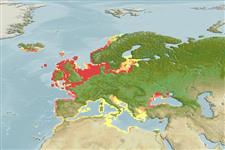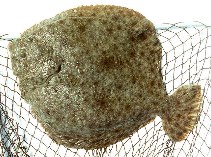Scophthalmus maximus (Linnaeus, 1758)
Turbot
Ajouter votre observation dans Fish Watcher
| Native range | All suitable habitat | Point map | Year 2050 |

|
| This map was computer-generated and has not yet been reviewed. |
| Scophthalmus maximus AquaMaps Data sources: GBIF OBIS |
Envoyez vos Photos et vidéos
Pictures | Videos | Stamps, coins, misc. | Images GoogleScophthalmus maximus
Picture by Quantz, G.
Pictures | Videos | Stamps, coins, misc. | Images GoogleScophthalmus maximus
Picture by Quantz, G.
Germany country information
Common names:
Haandreiß, Steinbutt, Steinbutte
Occurrence: native
Salinity: marine
Abundance: common (usually seen) | Ref: Winkler, H.M., K. Skora, R. Repecka, M. Ploks, A. Neelov, L. Urho, A. Gushin and H. Jespersen, 2000
Importance: | Ref:
Aquaculture: commercial | Ref: FAO Fishery Information, Data and Statistics Service, 1993
Regulations: | Ref:
Uses: no uses
Comments: Found in the Elbe estuary (Ref. 51031).
National Checklist:
Country Information: https://www.cia.gov/library/publications/resources/the-world-factbook/geos/gm.html
National Fisheries Authority: http://www.ble.de/index.cfm?8C712107D9244972B3C193AC1917DCE7#Handelsbezeichnungen
Occurrences: Occurrences Point map
Main Ref: Muus, B. and P. Dahlström, 1978
National Database: AGRDEU
Occurrence: native
Salinity: marine
Abundance: common (usually seen) | Ref: Winkler, H.M., K. Skora, R. Repecka, M. Ploks, A. Neelov, L. Urho, A. Gushin and H. Jespersen, 2000
Importance: | Ref:
Aquaculture: commercial | Ref: FAO Fishery Information, Data and Statistics Service, 1993
Regulations: | Ref:
Uses: no uses
Comments: Found in the Elbe estuary (Ref. 51031).
National Checklist:
Country Information: https://www.cia.gov/library/publications/resources/the-world-factbook/geos/gm.html
National Fisheries Authority: http://www.ble.de/index.cfm?8C712107D9244972B3C193AC1917DCE7#Handelsbezeichnungen
Occurrences: Occurrences Point map
Main Ref: Muus, B. and P. Dahlström, 1978
National Database: AGRDEU
Common names from other countries
Classification / Names Noms communs | Synonymes | Catalog of Fishes(Genre, Espèce) | ITIS | CoL | WoRMS | Cloffa
> Pleuronectiformes (Flatfishes) > Scophthalmidae (Turbots)
Etymology: Scophthalmus: Greek, skopelos = a lantern fish + Greek, ophthalmos = eyes (Ref. 45335).
More on author: Linnaeus.
Etymology: Scophthalmus: Greek, skopelos = a lantern fish + Greek, ophthalmos = eyes (Ref. 45335).
More on author: Linnaeus.
Environment: milieu / climate zone / depth range / distribution range Écologie
marin; saumâtre démersal; océanodrome (Ref. 51243); profondeur 20 - 70 m (Ref. 6302). Temperate; 70°N - 30°N, 25°W - 42°E
Distribution Pays | Zones FAO | Écosystèmes | Occurrences | Point map | Introductions | Faunafri
Northeast Atlantic: throughout the Mediterranean and along the European coasts to Arctic Circle; also found in most of the Baltic Sea. Subspecies Psetta maxima maeotica in the Black Sea.
Length at first maturity / Taille / Poids / Âge
Maturity: Lm 40.8, range 41 - 54 cm
Max length : 100.0 cm SL mâle / non sexé; (Ref. 4703); common length : 50.0 cm TL mâle / non sexé; (Ref. 35388); common length :70 cm TL (female); poids max. publié: 25.0 kg (Ref. 9988); âge max. reporté: 25 années (Ref. 32766)
Max length : 100.0 cm SL mâle / non sexé; (Ref. 4703); common length : 50.0 cm TL mâle / non sexé; (Ref. 35388); common length :70 cm TL (female); poids max. publié: 25.0 kg (Ref. 9988); âge max. reporté: 25 années (Ref. 32766)
Description synthétique Clés d'identification | Morphologie | Morphométrie
Body almost circular. Eye side without scales but with large bony tubercles (Ref. 35388).
Adults live on sandy, rocky or mixed bottoms; rather common in brackish waters. Feed mainly on other bottom-living fishes (sand-eels, gobies, etc.), and also, to a lesser extent, on larger crustaceans and bivalves. Batch spawner (Ref. 51846). Spawning season is between April and August; pelagic eggs. May reach 25 kg (Ref. 9988). Highly esteemed food fish. Utilized fresh or frozen; eaten steamed, pan-fried, broiled, boiled, microwaved and baked (Ref. 9988).
Life cycle and mating behavior Maturité | Reproduction | Frai | Œufs | Fécondité | Larves
Spawning usually happens between the months of February and April in the Mediterranean and from May to July in the Atlantic. Sequenced spawning every 2-4 days. Eggs have a single fat drop. Larvae are initially symmetric but, at the end of the metamorphosis (day 40-50, 25 mm), the right eye moves to the left side, losing its initial bilateral symmetry. Egg size 0.9 - 1.2 mm, larval length at hatching 2.7-3.1 mm.
Référence principale
Upload your references | Références | Coordinateur | Collaborateurs
Bauchot, M.-L., 1987. Poissons osseux. p. 891-1421. In W. Fischer, M.L. Bauchot and M. Schneider (eds.) Fiches FAO d'identification pour les besoins de la pêche. (rev. 1). Méditerranée et mer Noire. Zone de pêche 37. Vol. II. Commission des Communautés Européennes and FAO, Rome. (Ref. 3397)
Statut dans la liste rouge de l'IUCN (Ref. 130435: Version 2024-2)
Préoccupation mineure (LC) ; Date assessed: 07 December 2020
Menace pour l'homme
Harmless
Utilisations par l'homme
Pêcheries: commercial; Aquaculture: commercial; pêche sportive: oui; Aquarium: Aquariums publics
FAO(Aquaculture systems: production, Résumé espèce; pêcheries: production; publication : search) | FIRMS (Stock assessments) | FishSource | Sea Around Us
Plus d'informations
Trophic ecology
Éléments du régime alimentaire
Composition du régime alimentaire
Consommation alimentaire
Food rations
Prédateurs
Éléments du régime alimentaire
Composition du régime alimentaire
Consommation alimentaire
Food rations
Prédateurs
Population dynamics
Paramètres de croissance
Max. ages / sizes
Length-weight rel.
Length-length rel.
Fréquences de longueurs
Mass conversion
Recrutement
Abondance
Paramètres de croissance
Max. ages / sizes
Length-weight rel.
Length-length rel.
Fréquences de longueurs
Mass conversion
Recrutement
Abondance
Life cycle
Reproduction
Maturité
Fécondité
Frai
Spawning aggregations
Œufs
Développement de l'œuf
Larves
Dynamique des populations larvaires
Reproduction
Maturité
Fécondité
Frai
Spawning aggregations
Œufs
Développement de l'œuf
Larves
Dynamique des populations larvaires
Anatomy
Surface branchiale
Brain
Otolith
Surface branchiale
Brain
Otolith
Physiology
Body composition
Nutrients
Consommation d'oxygène
Type de nage
Vitesse de nage
Visual pigments
Fish sound
Diseases & Parasites
Toxicity (LC50s)
Body composition
Nutrients
Consommation d'oxygène
Type de nage
Vitesse de nage
Visual pigments
Fish sound
Diseases & Parasites
Toxicity (LC50s)
Human related
Aquaculture systems
Profils d'aquaculture
Souches
Ciguatera cases
Stamps, coins, misc.
Aquaculture systems
Profils d'aquaculture
Souches
Ciguatera cases
Stamps, coins, misc.
Outils
Bio-Quiz | E-book | Guide de terrain | Clés d'identification | Générateur de fréquences de longueur | Outil de dynamique de population | Carte par point | Classification Tree
| Catch-MSY |
Articles particuliers
Télécharger en XML
Sources Internet
Alien/Invasive Species database | Aquatic Commons | BHL | Cloffa | Websites from users | FishWatcher | CISTI | Catalog of Fishes(Genre, Espèce) | DiscoverLife | DORIS | ECOTOX | Faunafri | Fishtrace | GenBank(génôme, nucléotide) | GloBI | GOBASE | | Google Books | Google Scholar | Google | IGFA World Record | MitoFish | Bases de données nationales | Otolith Atlas of Taiwan Fishes | Aquariums publics | PubMed | Reef Life Survey | Scirus | SeaLifeBase | Arbre de Vie | Wikipedia(aller à, chercher) | World Records Freshwater Fishing | Zoological Record
Estimates based on models
Preferred temperature (Ref. 115969): 5.9 - 11.9, mean 9.4 (based on 239 cells).
Phylogenetic diversity index (Ref. 82804): PD50 = 0.5645 [Uniqueness, from 0.5 = low to 2.0 = high].
Bayesian length-weight: a=0.01122 (0.00922 - 0.01365), b=3.06 (3.00 - 3.12), in cm Total Length, based on LWR estimates for this species (Ref. 93245).
Niveau trophique (Ref. 69278): 4.4 ±0.0 se; based on diet studies.
Résilience (Ref. 120179): Milieu, temps minimum de doublement de population : 1,4 à 4,4 années (K=0.15-0.28; tm=3-5; tmax=26; Fec=5 million).
Prior r = 0.50, 95% CL = 0.33 - 0.75, Based on 9 full stock assessments.
Fishing Vulnerability (Ref. 59153): High vulnerability (60 of 100).
Climate Vulnerability (Ref. 125649): High vulnerability (65 of 100).




